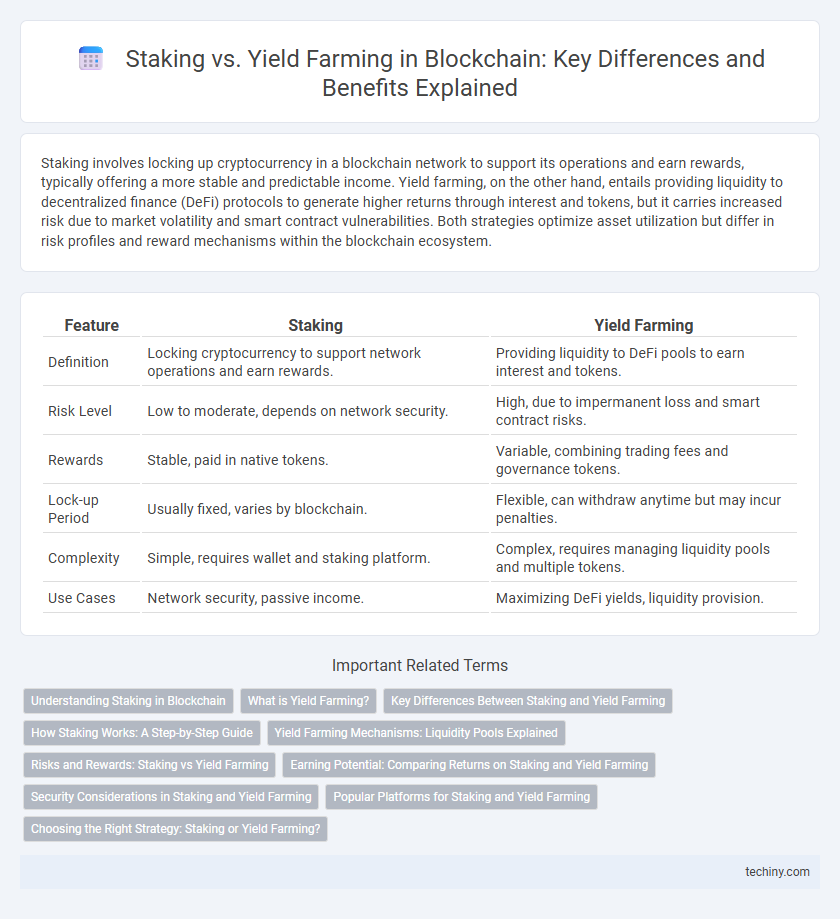Staking involves locking up cryptocurrency in a blockchain network to support its operations and earn rewards, typically offering a more stable and predictable income. Yield farming, on the other hand, entails providing liquidity to decentralized finance (DeFi) protocols to generate higher returns through interest and tokens, but it carries increased risk due to market volatility and smart contract vulnerabilities. Both strategies optimize asset utilization but differ in risk profiles and reward mechanisms within the blockchain ecosystem.
Table of Comparison
| Feature | Staking | Yield Farming |
|---|---|---|
| Definition | Locking cryptocurrency to support network operations and earn rewards. | Providing liquidity to DeFi pools to earn interest and tokens. |
| Risk Level | Low to moderate, depends on network security. | High, due to impermanent loss and smart contract risks. |
| Rewards | Stable, paid in native tokens. | Variable, combining trading fees and governance tokens. |
| Lock-up Period | Usually fixed, varies by blockchain. | Flexible, can withdraw anytime but may incur penalties. |
| Complexity | Simple, requires wallet and staking platform. | Complex, requires managing liquidity pools and multiple tokens. |
| Use Cases | Network security, passive income. | Maximizing DeFi yields, liquidity provision. |
Understanding Staking in Blockchain
Staking in blockchain involves locking up cryptocurrencies in a proof-of-stake (PoS) network to support transaction validation and network security, earning rewards in return. Validators are chosen based on the amount staked, which incentivizes holding tokens and reduces network attacks. Staking differs from yield farming by emphasizing network participation rather than liquidity provision, making it a lower-risk method for generating passive income within blockchain ecosystems.
What is Yield Farming?
Yield farming is a DeFi strategy where users lock or lend their cryptocurrencies in liquidity pools to earn rewards or interest, often in the form of additional tokens. It maximizes returns by leveraging multiple protocols, tapping into token incentives and transaction fees across decentralized exchanges. Yield farming typically involves higher risk compared to staking due to market volatility and smart contract vulnerabilities.
Key Differences Between Staking and Yield Farming
Staking involves locking up a cryptocurrency to support blockchain network security and operations, earning rewards typically in the form of interest or additional tokens. Yield farming, on the other hand, requires providing liquidity to decentralized finance (DeFi) protocols, earning returns through fees and token incentives, often with higher risk and complexity. The key differences lie in staking's focus on network consensus participation and relatively stable returns versus yield farming's active liquidity provision and potential for higher, but more volatile, yields.
How Staking Works: A Step-by-Step Guide
Staking involves locking up cryptocurrency assets in a blockchain network to support its operations and secure the network, earning rewards in return. Users delegate or lock their tokens in a wallet or on a platform, which participates in validating transactions and maintaining consensus through Proof of Stake (PoS) mechanisms. The longer and more tokens staked, typically the higher the yield, with rewards distributed periodically based on network rules and staked amount.
Yield Farming Mechanisms: Liquidity Pools Explained
Yield farming leverages liquidity pools, where users lock their crypto assets to provide liquidity for decentralized exchanges, earning rewards in return. These pools operate on smart contracts that automatically facilitate asset swaps, interest distribution, and incentive allocation. The mechanism incentivizes participants with governance tokens and transaction fees, driving decentralized finance (DeFi) growth and liquidity availability.
Risks and Rewards: Staking vs Yield Farming
Staking offers relatively stable rewards by locking cryptocurrencies in a proof-of-stake network, minimizing risk but often with lower returns compared to yield farming. Yield farming involves providing liquidity to decentralized finance (DeFi) protocols, presenting higher potential rewards alongside increased risks such as smart contract vulnerabilities and impermanent loss. Investors must balance the consistent, lower-risk staking approach against the high-reward yet volatile nature of yield farming when optimizing their blockchain asset strategies.
Earning Potential: Comparing Returns on Staking and Yield Farming
Staking offers relatively stable returns by locking tokens in a blockchain network to support consensus, typically yielding between 5% to 20% annually depending on the protocol. Yield farming, on the other hand, involves providing liquidity to decentralized finance (DeFi) platforms and can generate higher returns, often exceeding 30%, but carries increased risk due to market volatility and smart contract vulnerabilities. Evaluating the earning potential requires balancing the lower, predictable income from staking with the higher, variable yields from yield farming strategies.
Security Considerations in Staking and Yield Farming
Staking offers enhanced security by requiring token holders to lock assets in a network's proof-of-stake protocol, reducing risk of slashing but exposing users to potential validator misbehavior or network attacks. Yield farming involves higher smart contract risk due to complex DeFi protocols, increasing vulnerability to hacks, impermanent loss, and rug pulls. Assessing the security audits of platforms and the robustness of underlying blockchain technology is crucial when choosing between staking and yield farming strategies.
Popular Platforms for Staking and Yield Farming
Popular staking platforms like Ethereum 2.0, Cardano, and Polkadot enable users to earn passive income by locking up their tokens to support network security. Yield farming platforms such as Uniswap, PancakeSwap, and Aave offer liquidity providers rewards by allowing them to supply assets to decentralized pools. Both staking and yield farming attract investors seeking decentralized finance (DeFi) opportunities with varying risk and reward profiles.
Choosing the Right Strategy: Staking or Yield Farming?
Choosing between staking and yield farming depends on risk tolerance, desired returns, and time commitment; staking offers more stable and predictable rewards by locking tokens in a blockchain network, while yield farming involves higher risk and complexity with potentially greater yields through liquidity provision in DeFi protocols. Understanding the underlying smart contracts, impermanent loss risks, and platform security is crucial for making an informed decision. Evaluating the tokenomics, reward structures, and personal investment goals ensures alignment with either steady income from staking or aggressive growth through yield farming.
Staking vs Yield farming Infographic

 techiny.com
techiny.com